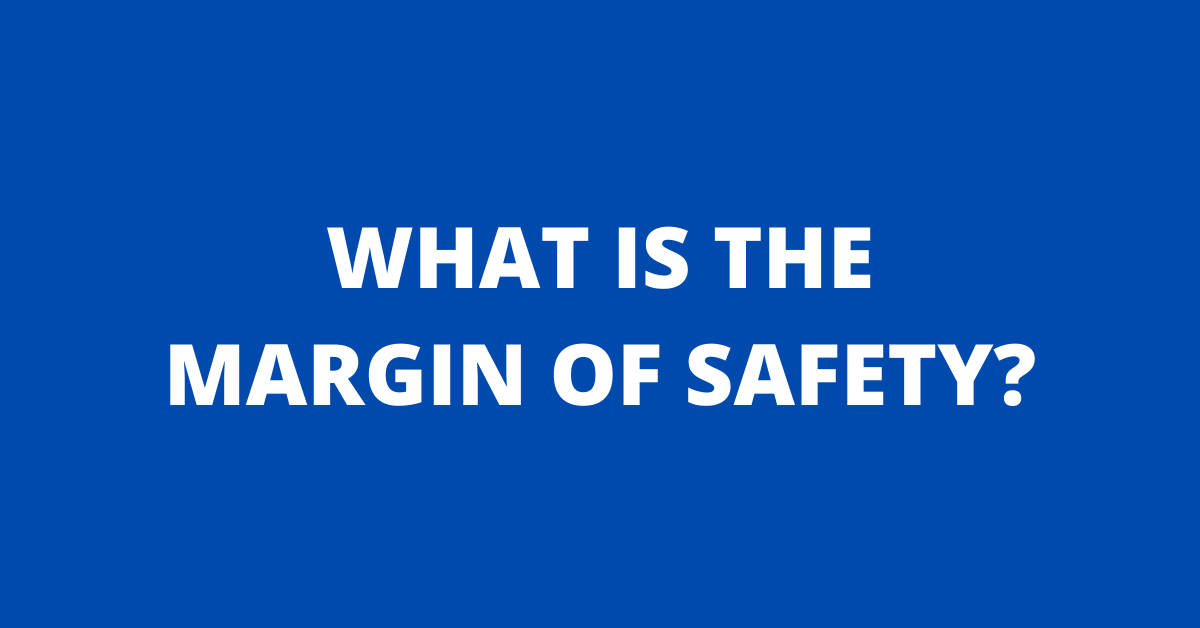The concept of margin of safety can be applied to accounting and to investing. For accounting, it is the difference between actual sales and break-even sales in accounting terms. By using it, accountants are able to calculate how much sales can drop before the company turns unprofitable.
When it comes to investing, the margin of safety represents the difference between the intrinsic value of a business and the price it is trading at. This allows investors to determine the value of the right price in order to buy a business, and have a safety cushion.
Although both the accounting and investing uses of safety margin are related, they are used in different situations.
Margin of safety in accounting
In accounting, it refers to the difference between the projected profits and the break-even point of the company. The break-even point is the point at which the company makes no profit or loss. It means the revenue collection above the break-even point is the margin of safety.
Formula in accounting
The margin of safety can be calculated in different ways. It can be calculated in terms of units, dollar value, or percentage of sales. The approach remains the same for all three methods though.
Margin of Safety = (Actual Sales – Break-even Point/Actual Sales) × 100
Actual sales refer to the current sales in a specific period. A company can use different accounting periods to calculate the margin of safety.
If the company wants to calculate the safety margin for its budgeting analysis, it can replace the actual sales figure with the budgeted sales figure.
The formula will adjust as:
Margin of Safety = (Budgeted Sales – Break-even Point/ Budgeted Sales) × 100
The company can calculate in terms of units as well.
Margin of Safety = (Budgeted Sales Units – Break-even Point/ Budgeted Sales Units) × 100
All three variations use the same approach of calculating the break-even point first. The margin of safety can then be calculated with different variations.
Why it is used in accounting
It informs a company about its risk of loss should a change or reduction in production occurs. It tells the management how much the company’s revenues can decline before the company becomes unprofitable.
In budgetary controls, the company can use it as a control metric. Specifically, when a company anticipates a decline in sales it can cut expenses to keep the margin of safety positive.
When measuring it in terms of units, the company can estimate the production level. It helps a business maintain a certain output level that keeps the revenue above the break-even point.
The concept can be applied to segments of the business or the company as a whole. The management can use it to measure the risk of loss if business sales decline.
Conversely, a business would want to keep it higher so that a temporary decline in sales does not affect the profits.
Margin of safety in investing
The margin of safety in investing refers to the difference in the market price of a security and its intrinsic value. Investors use it to buy securities when they are trading below their intrinsic values. The difference between the intrinsic value and the price at which is trading is the margin of safety.
An investor can set its own margin of safety, as a way to protect its downside risk. However, the margin of safety when it relates to stocks is totally dependable on the valuation of the business. Different investors will attribute different valuations based on their expertise.
There is no guarantee that a stock or security cannot fall below its intrinsic value. The process depends largely on investing judgment and some assumptions.
The concept of margin of safety is highly subjective in investing, and it tends to be associated with value investing.
There are no set rules that determine the true worth or intrinsic value of a stock. Thus, the margin of safety for the same stock can be different for different investors.
The use of the margin of safety is difficult as investors cannot predict a company’s profits or other performance metrics accurately. However, it can still be a valuable investing approach when done precisely.
Importance of margin of safety
Businesses can use this concept to protect themselves against market volatility. The higher the margin of safety the better it is for a business.
It can help a business analyze the risk of loss due to a decline in sales. A business can estimate its safety cushion with declining revenues. In other words, a business can estimate how much it can afford to lose before it starts incurring losses.
The concept is also widely used in forecasting and break-even analysis. It helps a business to forecast sales and adjust its budgets accordingly.
Limitations
Despite several uses, this method has some limitations as well. Calculation of margin of safety depends largely on the break-even point figures. Thus, it does not offer a direct analytical view.
In investing, the margin of safety is a very subjective measure. Investors can have varying views on the intrinsic value of a stock. Thus, there are no set rules to determine the safety margin in investing.

